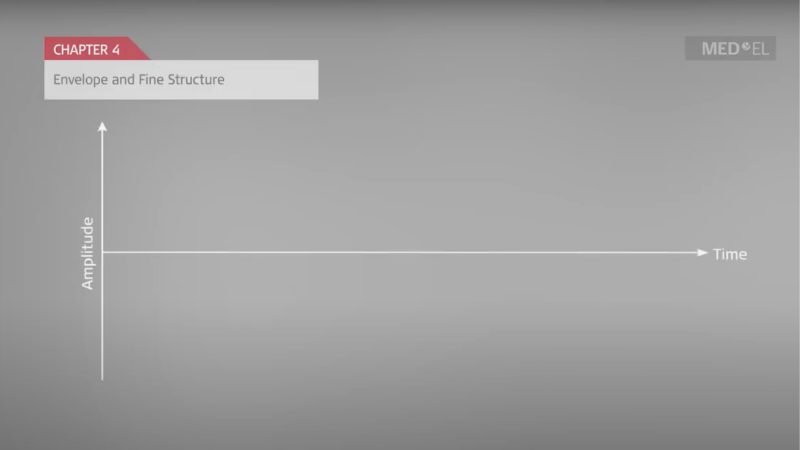
MED-EL
Published Apr 30, 2014
Envelope and Fine Structure: the Sounds of FineHearing
In an earlier post we helped answer the question “What is sound?” by showing that sound is basically lots of molecules in the air bouncing against each other. Today we’ll explore how a cochlear implant turns sound into the envelope and fine structure: information that the brain can understand.

Sound in Cochlear Implants
There are two major parts to a cochlear implant: the external audio processor and the internal implant. Each plays a big role in converting sound waves into electrical signals. The first part is the audio processor. As its name suggests, the audio processor is where sound gets processed. It does this with algorithms that are called “sound coding strategies,” which convert sound waves into digital data. There are different sound coding strategies that have been developed since the first cochlear implant, and MED-EL’s newest technology is called FineHearing.
The next is the implant. When the implant receives this digital data, it uses the data to create electronic pulses; these pulses are then sent to the cochlea via the electrode array. These pulses stimulate the nerve structures of the cochlea and allow a recipient to hear the sound as processed by the sound coding strategy.
Envelope and Fine Structure
FineHearing splits sound into two different parts, the envelope and the fine structure. In general, the envelope contains information that can help recipients understand speech, while the fine structure helps in appreciating music and other details of sounds. Sounds like human speech are what the envelope is about. CI sound coding strategies reproduce the envelope by sending a steady stream of electrical pulses to the cochlea. Different sounds are created by varying the pulse’s intensity (to match the sound’s amplitude) and where it stimulates the cochlea (to match how the ear hears different frequencies of sound). Because envelope-only strategies don’t vary the speed of these pulses, they can be relatively simple.
But they usually can’t reproduce more complex sounds like music, or low-frequency sounds, with accuracy. This where the fine structure comes in. What does fine structure add? Precision and control. Like the envelope, fine structure information is sent to the cochlea in pulses. However, the fine structure pulses aren’t consistent: sometimes they’re fast and sometimes they’re slow. This is intentional. By varying the speed of the pulses, the strategy can match the speed of the pulse speed to the frequency of the sound it reproduces (For example, a sound of 125 Hertz will be represented by pulses at a ‘speed’ of 125 Hertz).
This allows these low-frequency sounds to be heard much more accurately, and can give richer and fuller hearing. Fine structure information is ideal for reproducing the complex tones in music: in a study of 46 CI recipients, up to 93% said that FineHearing is better than other sound coding strategies (CIS+ and HDCIS) for listening to music Müller, J., et al. (2012) Clinical Trial Results with the MED-EL Fine Structure Processing Coding Strategy in Experienced Cochlear Implant Users. Journal for Oto-Rhino-Laryngology, Head and Neck Surgery. 74, 185-198. 10.1159/000337089 Smith, Z. M., Delgutle, B., & Oxenham, A. J. (2002, March 7). Chimaeric sounds reveal dichotomies in auditory perception. Nature, 416, 87-90. Müller, J., et al. (2012) Clinical Trial Results with the MED-EL Fine Structure Processing Coding Strategy in Experienced Cochlear Implant Users. Journal for Oto-Rhino-Laryngology, Head and Neck Surgery. 74, 185-198. 10.1159/000337089
Want to see how the envelope and fine structure combine? Here’s a nifty video showing just that:
References
-
[1]
Müller, J., et al. (2012) Clinical Trial Results with the MED-EL Fine Structure Processing Coding Strategy in Experienced Cochlear Implant Users. Journal for Oto-Rhino-Laryngology, Head and Neck Surgery. 74, 185-198. 10.1159/000337089
-
[2]
Smith, Z. M., Delgutle, B., & Oxenham, A. J. (2002, March 7). Chimaeric sounds reveal dichotomies in auditory perception. Nature, 416, 87-90.
References

MED-EL
Was this article helpful?
Thanks for your feedback.
Sign up for newsletter below for more.
Thanks for your feedback.
Please leave your message below.
Thanks for your message. We will reply as soon as possible.
Send us a message
Field is required
John Doe
Field is required
name@mail.com
Field is required
What do you think?
© MED-EL Medical Electronics. All rights reserved. The content on this website is for general informational purposes only and should not be taken as medical advice. Contact your doctor or hearing specialist to learn what type of hearing solution suits your specific needs. Not all products, features, or indications are approved in all countries.

MED-EL

MED-EL



